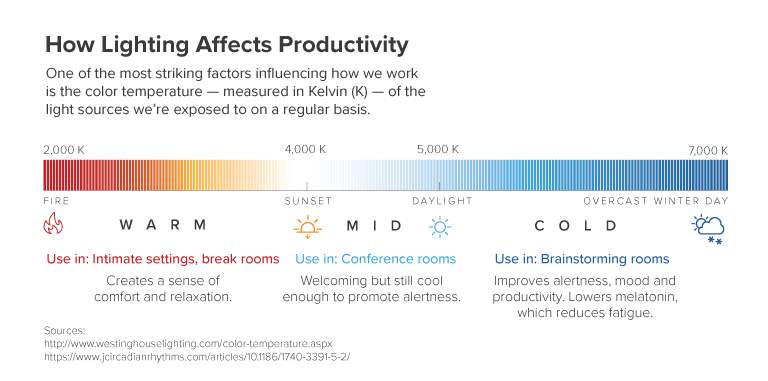HOW LIGHTING AFFECTS THE PRODUCTIVITY OF YOUR WORKERS

Modern day workers spend more time in the office, but if they’re not working smarter, they aren’t doing much for their employers. This might sound like a simple insight, but companies that understand what drives productivity get the most out of their talent and, as a result, produce better products, offer greater service and, ultimately, generate higher revenue.
One of the most striking factors influencing how we work is the color temperature of the light source we’re exposed to on a regular basis.
“Light has an enormous effect on our physical and mental well-being,” said Stanley Felderman of Felderman Keatinge & Associates, a design studio he runs with Nancy Keatinge. The husband-wife duo believes that it’s in our DNA to perform better under specific lighting, and that’s why we react differently depending on our light environment.
Understanding Variations in Lighting
For those unfamiliar with lighting temperatures and colors, what do they mean?
Temperature of light, measured in Kelvin (K), is a numerical measurement of the color that’s emitted when an object is heated in a high enough temperature. As the temperature increases, the object changes colors and emits certain colors of that light.
Just take, for example, a blacksmith heating up an iron horseshoe. As the temperature increases, the horseshoe will start to glow different colors from red, then orange, then yellow, then white, and, finally, it will emit a bluish-white color. Lower color temperature light sources are called “warm” because they emit red, orange and yellow color, whereas higher color temperature light sources are called “cool” because they are on the violet and blue end of the color spectrum.
Below is a rundown of the color temperatures in light sources:
Higher color temperatures (4,600K or more) appear blue-white and are called cool or daylight colors.
Mid-range color temperatures (3,100K–4,600K) appear cool white.
Lower color temperatures (up to 3,000K) range from red to yellowish-white in tone and are called warm colors.
For a better idea, Felderman and Keatinge gave some examples of what these color temperatures look like in everyday life:
- The glow-from-the-fire lighting is about 2,000K and is considered a warm color.
- A sunset is about 4,000K and is considered a cool white color.
- A typical sunny day is about 5,000K or 5,500K and is considered a cool color.
- An overcast winter day is measured at about 7,000K and is considered a cool color.

So, according to science and experts, what color temperature lighting is most beneficial in a work setting?
It turns out cooler light makes workers more productive. A number of studies have found sunlight can have a multitude of benefits on our health. Exposure to natural light is especially beneficial to workers cooped up in an office all day. Natural light from both the morning and evening has been found to decrease depression and improve mood, energy, alertness and productivity.
As a result of these findings, Felderman and Keatinge prefer to bring down drywall and “use an extensive amount of glass” in the offices they design. With this strategy, light is able to travel and disperse throughout the office space.
Tailoring Lighting Throughout the Office
If you don’t have access to daylight, studies have also found that working under “blue-enriched” light bulbs that are 17,000K actually increases work performance by supporting mental acuity, vitality and alertness while reducing fatigue and daytime sleepiness. Researchers at the University of Greenwich found in a two-month study that the workers they put under “blue-enriched light bulbs” reported feeling “happier, more alert and had less eye strain.”
Other benefits of blue light include lowering melatonin, which is created in our glands and basically puts us to sleep. This lower level of melatonin keeps people alert in the same way coffee does.
With so many brainpower benefits, blue or cooler light should be kept in brainstorming rooms where you want people to feel invigorated and excited to share their ideas, according to Felderman and Keatinge.
On the other hand, since warmer tones tend to create a sense of comfort, use this kind of lighting in more intimate settings where you want workers to feel calm and relaxed, perhaps in a meeting room where you want to emit trust.
Conference rooms should have middle tones that produce a friendly and inviting environment, but also cool enough tones to keep workers alert and motivated.
Throughout the day, light also needs to change since space acts like a working organism, according to Felderman and Keatinge. Earlier in the day, lighting in the office should be cooler and blue and should gradually change to a warmer, yellow color as the day progresses.
Programmable Lighting—The Next Big Thing?
The most innovative companies are already discovering the power of strategic lighting.
“You’re going to see, in the next six months to a year, major changes in lighting technology in companies,” said Felderman. “More and more companies will have programmable lighting that will be able to be changed as one desires.”
The next time you find yourself eager to get into the office in the early hours and not mind staying late after hours, it’s possible that new lighting has changed your rhythm and given you a slight advantage.
Citation for this content: MBA@UNC, UNC Kenan-Flagler’s online MBA program

Bio:Vivian Giang writes about leadership, entrepreneurship, workplace psychology, gender conversations and whatever else she finds interesting related to work and play. Her work has appeared on Fast Company, Fortune, Quartz, Slate, Marie Claire magazine, among others. You can find her on Twitter at @vivian_giang.


